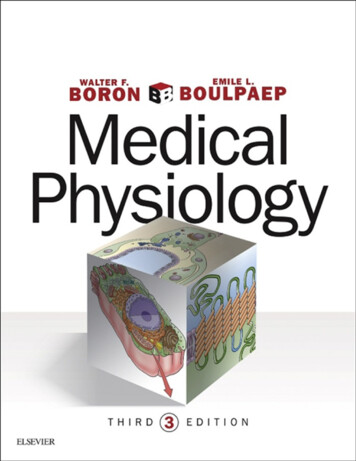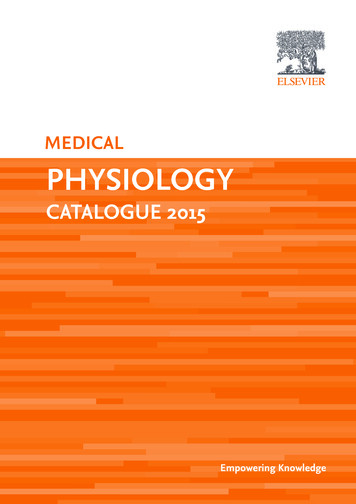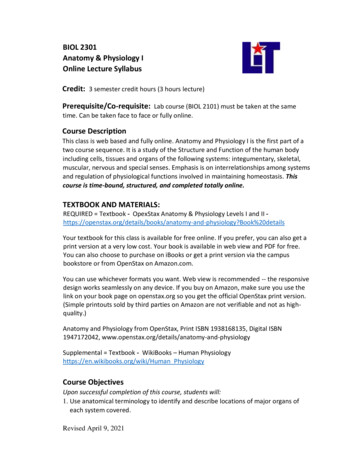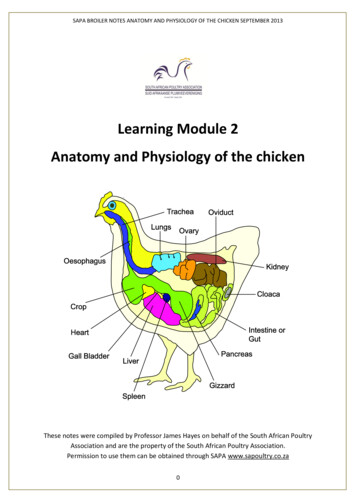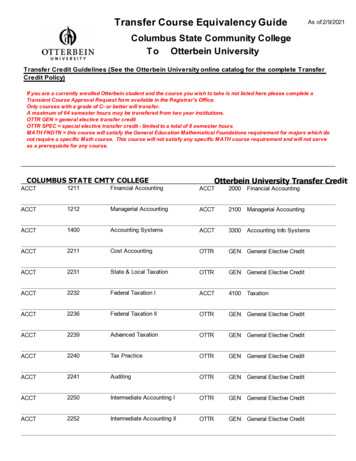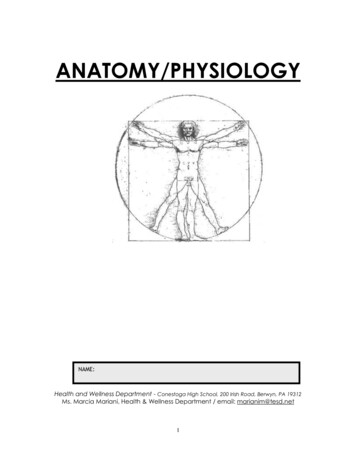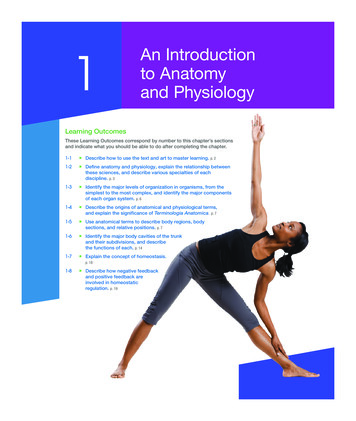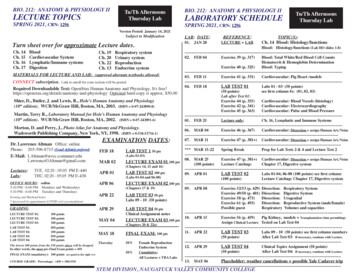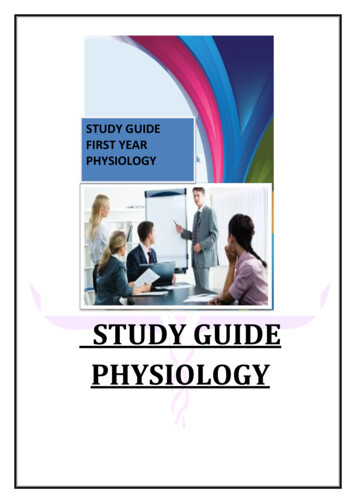
Transcription
STUDY GUIDEFIRST YEARPHYSIOLOGYSTUDY GUIDEPHYSIOLOGY
TABLE OF CONTENTS12CONTENTPhysiology department in a glancePhysiology department team- AFMDC34567891011Time line for syllabus completionTime tableSyllabus outlineLearning objectivesPractical ListLearning MethodologiesAssessment Methodologies and feedbackTextbooks and referencesTable of specificationsPage No.345671021222324252
PHYSIOLOGY DEPARTMENT IN A GLANCEOur body is nothing short of an amazing m a chine. No machine ever constructed canperform even a minutest body-like function as effectively as our bodies can do.Physiology aims to understand the fascinating mechanisms of our body. Humanphysiology studies how our cells, muscles and organs work together, how they interact.Physiology, sometimes referred to as “the science of life”, looks at living mechanismsfrom molecular basis of cell function to the whole integrated behavior of the entire body.Our shared vision is to develop high quality professionals to pursue the excellence in thefield of medicine and surgery. Our mission here at the department of Physiology AFMDCis:To provide theoretical and practical knowledge /skills through quality teachingTo provide standard education and practical skillsTo impart under graduate students a quality education to cope up with the internationalstandardsPhysiology department has highly experienced, skilled and qualified faculty andlaboratory staff focused on delivering quality education and skills. The Physiology is wellequipped with all necessary equipment’s along with latest power lab. It has the capacityof 35 students.The department has also computer facility to maintain departmental record, preparelecture slides and demonstrate audiovisual aids.Teaching strategy includes interactive lecture, small group tutorial, and practical toprovide flexible multi method learning opportunities.Students are continuously assessed depending upon their performance throughout theyear. Seminar and quiz are also conducted and arranged to involve the students and toincrease their interest level. Teachers focus on self-expression, discovery and enthusiasmamong learners.3
Physiology Department Team- AFMDCPositionsNameHead of DepartmentProf. Dr. Farah Amir AliAssociate ProfessorAssistant ProfessorSenior DemonstratorsDemonstratorsDr. Shireen javedDr. Beenish AltafDr. Shakeela NazDr. AnamDr. JaveriaDr. RoohaLaboratory InchargeMr. Abdul RehmanComputer operatorLaboratory assistantMr. Wasim RiasatMr. Abdul NaveedLaboratory attendantMr. Matloob4
TIME LINE for SYLABUS COMPLETIONGHANTT CHART of FIRST YEAR LECTURESTopicDecJanFeb March April May June July Aug SEPCellGeneticsNerve andmuscleBloodHeartCirculationRespirationWinter breakMid-session examSummer vacationssendup exam5
TIME 512:4513:1513:1515:00Lec PhyPracticalDateMondayTuesdayLec PhyPracticalWednesdayLec PhyThursdayTutorialLec 0Lec PhyTutorialPractical11:3013:0013:0015:00Friday6
SYLLABUS OUTLINE PHYSIOLOGYThe course outline is as follows:BASIC AND CELL PHYSIOLOGY1. Functional organization of human body2. Homeostasis3. Control systems in the body4. Cell membrane and its functions5. Cell organelles and their functions6. Genes --their control and functionBlood1. Composition and general functions of blood2. Plasma proteins their production and function3. Erythropoiesis and red blood cell function4. Structure, function, production and different types of haemoglobin5. Iron absorption storage and metabolism6. Blood indices7. Function, production and type of white blood cells8. Function and production of platelets9. Clotting mechanism of blood10. Blood groups and their role in blood transfusion11. Complications of blood transfusion with reference to ABO & RH incompatibility12. Components of reticuloendothelial system their gross and microscopic structureincluding (tonsil, lymph node and spleen)13. Development and function of reticuloendothelial systemClinical Module1. Anemia and its different types2. Blood indices in various disorders3. Clotting disorders (Haemophilia etc.)4. Blood grouping and cross matching5. ImmunityNerve and Muscle1. Structure and function of neuron2. Physiological properties of nerve fibers3. Physiology of action potential4. Conduction of nerve impulse5. Nerve degeneration and regeneration6. Synapses7. Physiological structure of muscle8. Skeletal muscle contraction9. Skeletal, smooth and cardiac muscle contraction10. Neuromuscular junction and transmission11. Excitation contraction coupling12. Structure and function of motor unitClinical Module1. Perform nerve conduction studies and explain their clinical importance7
2. Myopathies and neuropathies3. Peripheral nerve injuriesCardiovascular System1. Heart and circulation2. Function of cardiac muscle3. Cardiac pacemaker and cardiac muscle contraction4. Cardiac cycle5. ECG, its recording and interpretation6. Common arrhythmias and its mechanism of development7. Types of blood vessels and their function8. Hemodynamics of blood flow (local control systemic circulation its regulationand control)9. Peripheral resistance its regulation and effect on circulation10. Arterial pulse11. Blood pressure and its regulation12. Cardiac output and its control13. Heart sounds and murmurs14. Importance, circulation, and control of venous returnon15. Coronary circulation16. Splanchnic, pulmonary and cerebral circulation17. Triple response and cutaneous circulation18. Foetal circulation and circulatory changes at birthClinical Module1. Clinical significance of cardiac cycle, correlation of ECG and heart sounds tocardiac cycle2. Clinical significance of cardiac cycle, interpretation of ischemia and arrhythmias3. Effects of hypertension4. Clinical significance of heart sounds5. Effects of ischemia6. ShockRespiratory System1. Function of respiratory tract2. Respiratory and non-respiratory function of the lungs3. Mechanics of breathing4. Production & function of surfactant and compliance of lungs5. Protective reflexes6. Lung volumes and capacities including dead space7. Diffusion of gases across the alveolar membrane8. Relationship between ventilation and perfusion9. Mechanism of transport of oxygen and carbon dioxide in blood10. Nervous and chemical regulation of respiration11. Abnormal breathing12. Hypoxia, its causes and effects13. Cyanosis, its causes and effectsClinical Module1. Clinical importance of lung function tests8
2. Causes of abnormal ventilation and perfusion3. Effects on pneumothoax, pleural effusion, and pneumonia4. Respiratory failure5. Artificial respiration and uses & effects of O2 therapy6. Clinical significance of hypoxia, cyanosis, and dyspnoeaSkin and Body Temperature RegulationPHYSIOLOGY PRACTICALSHaematology1. Use of the microscope2. Determination of haemoglobin3. Determination of erythrocyte sedimentation rate4. Determining packed cell volume5. Measuring bleeding and clotting time6. RBC count7. Red cell indices8. WBC count9. Leucocyte count10. Prothrombin and thrombin timeRespiratory System1. Pulmonary volume, their capacities and clinical interpretationCardiovascular System1. Cardiopulmonary resuscitation (to be coordinated with the department of medicine)2. Examination of arterial pulse3. ECG recording and interpretation4. Arterial blood pressure5. Effects of exercise and posture on blood pressure6. Apex beat and normal heart sounds9
LEARNING OBJECTIVES OF PHYSIOLOGYFIRST YEAR M.B.B.STOPICIntroduction toPhysiology: The Celland General PhysiologySUBTOPICSFunctionalOrganization ofthe Human Bodyand Control ofthe“InternalEnvironmentLEARNING OBJECTIVES Define human physiologyExplain the role of extracellular fluid as internal environment. Differentiate between extracellular and intracellular fluid . Associate the general concept of homeostasis along with role ofbody systems in maintaining it.Discuss feedback mechanism with its components.Explain negative feedback mechanism along with its examples.Discuss positive feedback mechanism with its examples.Define feed forward mechanism and adaptive control mechanismContrast the following units used to describe concentration: mM,mEq/l, mg/dl, mg%.List the typical value and normal range for plasma Na , K , H (pH), HCO3 - , Cl- , Ca2 , and glucose, and the typical intracellularpH and concentrations of Na , K , Cl- , Ca2 , and HCO3 - .Differentiate between the terms osmole, osmolarity, osmolality andtonicity.List the typical value and normal range for plasma osmolality. The Cell and ItsFunctions Genetic Controlof ProteinSynthesis, CellFunction, andCellReproduction Discuss general organization of cellDescribe the structure and function of cell membrane alongwith its cross section diagramEnlist cell organelles with its function.Compare smooth endoplasmic reticulum and roughendoplasmic reticulum.Differentiate between Lysosomes and PeroxisomesRelate lysosomal storage disease with its functionDiscover the role of cytoskeleton in maintaing the structure ofcell and in movementDiscuss the concept of molecular motorsEnlist different types of intercellular connectionsExplain the role of the “tight” junctions in leaky and tightepithelia.Describe the structure and function of DNADefine genetic code and gene with its different componentsDescribe structure of RNA and its typesInterpret the role of different types of RNA in transcription.Explain the process of transcription & post transcriptionalmodificationDiscuss the process of translation & post translational10
Membrane ,Nerve andMuscle PhysiologyTransport ofSubstancesThrough the CellMembrane MembranePotentials andAction Potentials modificationSummerize the regulation of gene expressionDiscuss the life cycle of cellDescribe the process of cell mitosisExplain the role of telomeres in cell reproductionDiscuss the apoptosis with role of caspasesAssociate abonormal activation of genes with cancerDifferentiate the following terms based on the source of energydriving the process and the molecular pathway for: diffusion,facilitated diffusion,osmosis, secondary active transport, andprimary active transport.Describe how transport rates of certain molecules and ions areaccelerated by specific membrane transport proteins(“transporter” and “channel” molecules).Contrast the types of active & passive transport with itsexamples in detailDescribe how energy from ATP hydrolysis is used to transportions such as Na , K , Ca2 , and H against theirelectrochemical differences (e.g., via the Na pump,sarcoplasmic reticulum Ca2 pump, and gastric H pump).Explain how energy from the Na and K electrochemicalgradients across the plasma membrane can be used to drive thenet “uphill” (against a gradient) movement of other solutesDefine diffusion potential and Nernst potentialExplain how the resting membrane potential is generatedCalculate membrane potential by using the Goldman-HodgkinKatz equation .Predict how the membrane potential would change,given anincrease or decrease in the permeability of K , Na , or Cl-.Explain the origin of normal resting membrane potentialDescribe the role of Na -K pump for maintainingconcentration gradient of Na & K ionsDefine the following properties of ion channels: gating,activation, and inactivation.Contrast the gating of ion-selective channels by ligands andvoltage.Illustrate how the activity of voltage-gated Na , K , and Ca2 channels generates an action potential and the roles of thosechannels in each phase (depolarization, overshoot,repolarization, hyperpolarization) of the action potential.Discuss the properties of action potentialContrast the mechanisms by which an action potential ispropagated along both nonmyelinated and myelinated axonsExplain the All or Nothing principleDefine and discuss refractory period with its typesEnumerate classification of nerve fibersDefine rheobase and chronaxieDifferentiate between the properties of electro tonicconduction, conduction of an action potential, and salutatoryconduction. Identify regions of a neuron where each type of11
electrical activity may be found.Contraction ofSkeletal Muscle Excitation ofSkeletal muscle:NeuromuscularTransmissionand ExcitationContractionCoupling Contraction andExcitation ofSmooth Muscle Explain the physiological anatomy of skeletal muscleDescribe the general mechanism of muscle contractionDiscuss cross bridge cycle,walk along theory and slidingfilament mechanismList the process of excitation contraction couplingDescribe the roles of the sarcolemma, transverse tubules,sarcoplasmic reticulum, thin filaments, and calcium ions inexcitation contraction couplingDescribe the roles of ATP in skeletal muscle contraction andrelaxation.Construct a table of structural, enzymatic, and functionalfeatures of the three major categories (fast-glycolytic, fastoxidative-glycolytic, and slow-oxidative fiber types) of skeletalmuscle fiber typesDistinguish between isotonic and isometric contractionDefine motor unit, summation, hypertrophy, hyperplasia andatrophyExplain the process of tantalization and treppeList the energy sources of muscle contraction and rank thesources with respect to their relative speed and capacity tosupply ATP for contractionDiscuss pathophysiology of Muscular Dystrophies in relation tocytoskeleton: Becker muscular dystrophy: Becker musculardystrophy and Duchenne muscular dystrophyDefine rigor mortisDraw the structure of the neuromuscular junction.List in sequence the steps involved in neuromusculartransmission in skeletal muscle and point out the location ofeach step on a diagram of the neuromuscular junction.Distinguish between an endplate potential and an actionpotential in skeletal muscle.List the possible sites for blocking neuromuscular transmissionin skeletal muscle and provide an example of an agent thatcould cause blockage at each siteCompare the presentation of myasthenia gravis and LambertEaton syndromeDescribe the distinguishing characteristics of multi-unit andunitary smooth musclesCompare smooth muscle contraction and skeletal musclecontraction in detailDiscuss the role of calcium, myosin light chain kinase andmyosin phosphatase in contraction of smooth muscleDistinguish between muscle relaxation from the contractedstateExplain why smooth muscles can develop and maintain forcewith a much lower rate of ATP hydrolysis than skeletalmuscle./Latch phenomenonDescribe physiologic anatomy of neuromuscular junction insmooth muscle12
CardiovascularphysiologyHeart physiology Heart Muscle;The Heart as aPump andFunction of theHeart Valves RhythmicalExcitation of theHeart Explain the two forms of action potential in unitary smoothmuscleDefine phenomenon of stress relaxationDiscuss the phenomenon of auto rhythmicity in some smoothmusclesEnlist the local factors that inhibits the smooth musclecontractionBased on ion permeability and electrical resistance describerole of gap junctions in creating a functional syncytium.Discuss action potential of cardiac muscle in detail.Describe the specific details about the specialrole of Ca2 in the control of contraction and relaxation ofcardiac muscleContrast the duration of the action potential and the refractoryperiod in a cardiac muscle, a skeletal muscle, and a nerve.Sketch the temporal relationship between an action potential ina cardiac muscle cell and the resulting contraction of that cellIdentify the intervals of isovolumic contraction, rapid ejection,reduced ejection, isovolumic relaxation, rapid ventricle filling,reduced ventricular filling and atrial contraction in cardiac cycleDraw, in correct temporal relationship, the pressure, volume,heart sound, and ECG changes in the cardiac cycleContrast the relationship between pressure and flow into andout of the left and right ventricles during eachphase of the cardiac cycle.Define the following terms:- End diastolic volume, Endsystolic volume, Stroke volume, Ejection fraction, preload andafter loadCalculate ejection from end diastolic volume, end systolicvolume, and/or stroke volume.Predict the change in ejection fraction that would result from achange in a) preload, b) afterload, and c) contractility.Draw a ventricular pressure-volume loop and on it label thephases and events of the cardiac cycle .Enlist difference between semilunar vs. AV valvesExplain the functions of papillary muscles in AV valvesDescribe the role of Starling’s Law of the Heart in keeping thecardiac outputExplain the role of parasympathetic & sympathetic nerves onheart pumpingDiscuss the effect of potassium and calcium ions of heartfunctionExplain the process of self excitation of SA node.Compare the action potential of sinus nodal fiber andventricular muscle fiberSketch a typical action potential in a ventricular muscle and apacemaker cell, labeling both the voltage and time axesaccurately.Describe how ionic currents contribute to the four phases ofthe cardiac action potentialIllustrate the conductive system of heartExplain why the AV node is the only normal electrical pathway13
CardiacArrhythmias andTheirElectrocardiographicInterpretation The CirculationOverview of theCirculation;Medical Physicsof Pressure,Flow, andResistanceVascularDistensibility andFunctions of theArterial andVenous Systems between the atria and the ventricles.Explain the functional significance of the slow conductionthrough the AV node.Describe factors that influence conduction velocity through theAV node.Discuss the cause of delay of impulse conduction from the atriato the ventricles.Define ectopic pacemakerThe above learning objective will be discussed in tutorial alongwith its clinical applicationsInterpret the characteristics of the normal electrocardiogram.Identify the voltage and time calibration of electrocardiogram.Recognize 12 electrocardiographic leads and their placementSummerize the principles of vectorial analysis ofelectrocardiogramsInterpret the electrical axis from standard lead ECGsEnlist the normal abnormal causes of axis deviationRecognize that cause increased and decreased voltage ofelectrocardiogramDefine current of injury and J point.Discuss changes in ECG in coronary ischemiaEnlist the ECG changes of Hyperkalemia and HypokalemiaDefine tachycardia and bradycardia along with causes.Illustrate atrio ventricular block (degree 1st , 2nd , 3rd )Discuss the significance of “overdrive suppression” and “ectopicpacemaker,” including the conditions necessary for each tooccur.Define premature contractions and its causeDescribe the alteration in conduction responsible for mostcommon arrhythmias: i.e., tachycardia, bradycardia, A-V block,Wolff-Parkinson-White (WPW) syndrome, bundle branch block,flutter, fibrillationThe above learning objective will be discussed in tutorial alongwith its clinical applicationsDemonstration of cardiopulmonary resuscitation (CPR)Describe physical characteristics of the circulationExplain basic theories of the circulatory functionsIllustrate interrelationship among pressure flow and resistancein vasculatureApply the above relationship to the arteries, arterioles,capillaries, venules, and veins.Discuss conductance of a blood is a vessel and its relation toresistanceExplain how Poiseuille’s Law influences resistance to flow.List the factors that shift laminar flow to turbulent flow.Discuss specific blood reservoirsContrast compliance and Distensibility.Define the following:- Delayed compliance (stress- relation) ofvessels, Mean arterial pressure ,Central venous pressureDescribe the effects of following factors on venous pressures :right atrial pressure, intraabdominal pressure, gravitational14
Microcirculationand theLymphaticSystem: CapillaryFluid Exchange,Interstitial Fluid,and Lymph Flow Control ofArterial Pressure pressure, venous valves and venous pumpsExplain normal, abnormal aortic pressure pulse contoursThe above learning objective will be discussed in tutorial alongwith its clinical applicationsExamination of pulseDetermination of JVPExplain acute control of local blood flow with following aspects: Tissue metabolism & When oxygen availability changes(vasodilator theory & oxygen lack theory)Differentiate reaction & active hyperemiaDiscuss Auto regulation of blood flow ( metabolic & myogenicmechanism)Identify the role of PO2 , PCO2 , pH, adenosine, and K in themetabolic control of blood flow to specific tissuesExplain the role of nitric oxide for dilating upstream arteriesDescribe role of oxygen and vascular endothelial growth factorsin long term blood flow regulationDiscuss autonomic nervous system & its effect on circulatorysystemContrast the sympathetic and parasympathetic nervous systemcontrol of heart rate, contractility, total peripheral resistance,and venous capacitancePredict the cardiovascular consequence of altering sympatheticnerve activity and parasympathetic nerve activity.Discuss the effect of sympathetic innervation on blood vesselsof skeletal muscleDescribe the parts of vasomotor center and their role inregulation of blood pressure.Define the following: I. Vasomotor tone II. Vasovagal syncopeEnumerate the reflexes involved in rapid(short term) control ofarterial pressureList the anatomical components of the baroreceptor reflex anddiscuss its receptors in detail.Explain the sequence of events in the baroreceptors reflex thatoccur after an acute increase or decrease in arterial bloodpressure with following aspects: a)Receptor response b)Afferent nerve activity c) CNS integration d)Efferent nerveactivity to heart and vessels e) ResponseOutline the cardiovascular reflexes initiated by decreases inblood O2 and increases in blood CO2.Describe role of chemoreceptors in regulation of arterialpressureDescribe the Cushing Reflex and the CNS ischemic responseExplain role of kidney in long term regulation of blood pressure.Discuss intermediate regulation of blood pressureContrast the relative contribution of neural and renalmechanisms in blood pressure and blood volume regulationDescribe the release, cardiovascular target organs andmechanisms of cardiovascular effects for angiotensin, atrialnatriuretic factor, bradykinin, and nitric oxide.Determination of blood pressure at rest, effects with change in15
Cardiac Output,Venous Return,and TheirRegulation Ischemic heartdiseases andheart failureHeart sound andcongenital heartdefects Circulatory shockand itstreatment Blood Cells,Immunity, andRed Blood Cells,Anemia, and posture and exerciseDefine cardiac output and cardiac indexIdentify the factors that cause a hyper effective and hypoeffective heartSummarize the pathophysiology of high and low cardiac outputDraw a graph showing relationship of cardiac output with rightatrial pressureDraw a graph showing relationship of venous return with rightatrial pressureExplain the effect of mean circulatory and mean systemic fillingpressure on venous returnInterpret the effect of venous return on venous return curveDiscuss the principles underlying cardiac output measurementsusing the oxygen Fick principle and indicator dye dilutionSummarize the blood flow regulation in skeletal muscle at restand during exerciseDiscuss ischemic heart disease with reference to myocardialinfarction & angina pectorisExplain role of collateral circulation in the heartEnlist causes of death after acute coronary occlusionExplain coronary steal syndromeExplain dynamic of compensated & uncompensated heartfailureEnumerate the consequences of right and left heart failureDiscuss the cardiac reserveDescribe the timing and causes of the four heart sounds.Describe the expected auscultation sounds that define mitralstenosis, mitral insufficiency, aortic stenosis, and aorticinsufficiency.Explain how these pathologic changes would affect cardiacmechanics and blood pressure.Discuss the abnormal circulatory dynamics in congenital heartdefects (patent Ductus arteriosus and tetralogy of Fallot)Clinical examination of chest and heart soundsRelate the three stages of shock ( non-progressive progressiveand irreversible shock)Describe the direct cardiovascular consequences of the loss of30% of the circulating blood volume on cardiac output, centralvenous pressure, and arterial pressure. Describe thecompensatory mechanisms activated by these changes.Explain three positive feedback mechanisms activated duringsevere hemorrhage that may lead to circulatory collapse anddeathContrast the change in plasma electrolytes, hematocrit,proteins, and colloid osmotic pressure following resuscitationfrom hemorrhage using a) water, b) 0.9% NaCl, c) plasma, andd) whole blood.Discuss the physiology of treatment in shockDescribe the components of blood (cells, ions, proteins,platelets) giving their normal values.16
Blood ClottingPolycythemia Resistance tobody infection Discuss erythropoiesisIdentify the source, stimulus for formation, and function of thehormone erythropoietin.Describe the functional consequence of the lack of a nucleus,ribosomes, and mitochondria for a) protein synthesis and b)energy production within the red blood cell.Discuss hemoglobin with respect to: Steps of synthesis,Reactions and Types (A, A1, F, S)Define the following : Oxyhemoglobin ,Methemoglobin,CarboxyHemoglobin and Car amino HemoglobinDetermination of hemoglobin by Sahlis MethodDiscuss iron metabolism (absorption, transport storage andutilization)Explain the function of ATPs in maintaining normal RBC’sfragilityEnlist the causes of vit B12 and folic acid deficiency.Define MCV, MCH and MCHC with formulaClassify anemia on the basis of etiologyInterpret blood picture of iron deficiency anemia andmegaloblastic anemiaDiscuss polycythemia with its typesCompare secondary and physiological polycythemiaThe above learning objective will be discussed in tutorial alongwith its clinical applicationsStudy of haemocytometerDetermination of RBC count in peripheral bloodDetermination of ESRDetermine the osmotic fragility of red blood cellsDiscuss the different types of WBC’s with its functionsList the genesis of myelocytes and lymphocytesDefine the following :a)Phagocytosis b) Chemotaxis c)Diapedesis d) Inflammation e)PusCompare Phagocytosis by Neutrophils and macrophagesDiscuss role of Neutrophils and macrophages duringinflammation (first, second, 3rd & 4th line of defense)Define : a)Leucopenia b) Leukemia’s. c)LeukocytosisExplain the role of monocyte- macrophage cell system(reticuloendothelial system)Explain the process of inflammation along with walling offeffectExplain the process of formation of pusThe above learning objective will be discussed in tutorial alongwith its clinical applicationsDetermination of TLCDetermination of DLCDefine immunity along with its typesDescribe the contributors of innate immunityDefine Antigen, epitope, plasma cells, memory cells, antigenpresenting cellsIllustrate the role of MHC proteins, in immune systemExplain types of Acquired immunity17
Blood types;transfusion;tissue and organtransplantationHemostasis andBloodCoagulation RespiratorysystemPulmonaryventilation Describe preprocessing of T and B lymphocytes during fetal lifeClassify immunoglobulin’s (Antibodies) along with theirimportant characteristicsDescribe the direct action of antibodies and by activation ofcomplement systemList types of T lymphocytes and their functionsIdentify role of Macrophages & CD4 cells in controlling theimmune systemDifferentiate between active and passive immunityExplain four types of hypersensitivityDescribe function of agglutinogens and agglutinins in relation toblood groups.Describe antibody and antigen of ABO systemDescribe mechanisms that inherit the ABO system.List phenotype and genotype of possible ABO types.Describe antibody and antigen of Rh system.Describe transfusion reaction related to ABO system and Rhsystem.Explain pathophysiology of Erythroblastosis fetalisDefine Allograft, auto graft, isograft and xenograftDiscuss Tissue typing (HLA typing)Define Hemostasis along with its stepsDiscuss the functions of plateletsExplain the mechanism of platelet plug formationContrast the thrombin formation by intrinsic and extrinsicpathway of coagulationEnlist the clotting factorsEnumerate the Vit k dependent clotting factorsEnlist anticoagulants in vivo and vitro with its usesExplain why activation of the clotting cascade does not clot allthe blood in the bodyThe above learning objective will be discussed in tutorial alongwith its clinical applicationsDetermination of bleeding timeDetermination of clotting timeDetermination of platelets count in peripheral bloodDiscuss the mechanics of pulmonary ventilation with followingaspects :Muscles of respiration & intra alveolar pressure andtrans pulmonary pressureDiagram how pleural pressure, alveolar pressure, airflow, andlung volume change during a normal quiet breathing cycle.Explain the factors affecting compliance of the lungsIdentify two clinical conditions in which compliance is higher orlower than normalDefine the following: 1) Tidal volume. 2) Inspiratory reservevolume. 3) Expiratory reserve volume 6) Residual volume.5) Inspiratory capacity. 6) Expiratory capacity. 7) Functionalresidual capacity. 8) Dead space. 9) Alveolar ventilation. 10)Minute respiratory volume 11) Minute alveolar ventilation. 12)Pleural effusion.18
PulmonaryCirculation,PulmonaryEdema, PleuralFluid Principles of gasexchange Regulation ofrespiration Draw a normal spirogram, labeling the four lung volumes andfour capacities.Define surface tensionDescribe how surface tension applies to lung mechanics,including the effects of alveolar size and the role of surfactants.Define atelectasis and the role of surfactants in preventing it.Enlist steps of cough reflex and compare it with sneeze reflex.SpirometryDescribe the physiologic anatomy of pulmonary circulatorysystem along with pres
STUDY GUIDE FIRST YEAR PHYSIOLOGY . 2 TABLE OF CONTENTS CONTENT Page No. 1 Physiology department in a glance 3 2 Physiology department team- AFMDC 4 3 Time line for syllabus completion 5 4 Time table 6 5 Syllabus outline 7 6 Learning objectives 10 7 Practical List 21 8 Learning Methodologies 22 .


